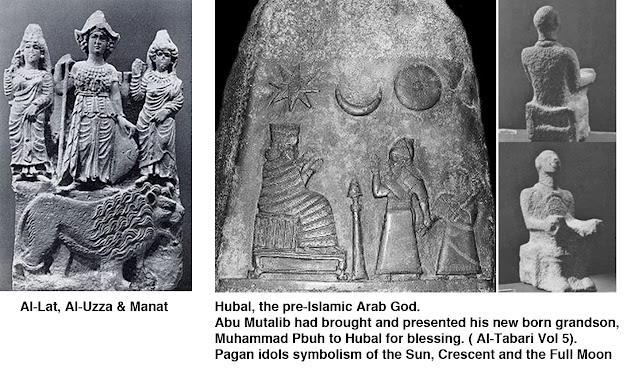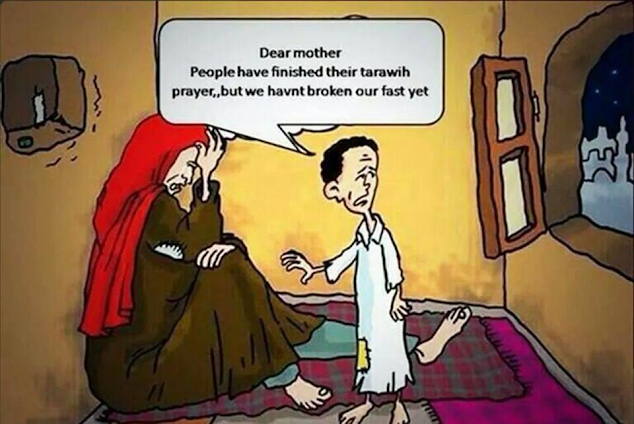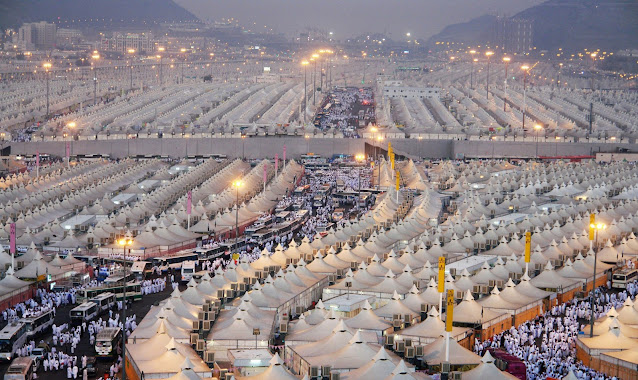Origins of the Hijra Calendar
Pre-Islamic Arab
Although the pre-Islamic religions of the Arabs were generally paganism, the various idols around the Kaaba were probably the result of sectarianism evolved into different manner of rituals and worship of pagan gods. The Kaaba was still the focal point of their pilgrimage, with the Black Stone (Hajar Aswad) as the most venerated stone worshipped by all the pagans. This is almost similar to the current situation where Shia, Sunni and other Islamic sects having different form of worship but still face the Kaaba as the Qibla, and the Hajar Aswad as the stone of veneration. All Muslim still return or turn towards the Kaaba despite having different principles and ideological underpinnings.
Hubal, Dhu-Shara, Al-Lat, Al-Uzza, & Manat were the well known pagan gods and idols known to be worshipped in around the Kaaba by the pagan and polytheist Arabs. This is common in almost every culture that believes in unseen superior forces at work. They then evolved into an ideology of worship that attributed these forces into various gods or idols. Despite their differences, the pre-Islamic Arabs still congregate during the winter month their pilgrimage rituals in Makkah. This is why this winter pilgrimage month was called Dhulhijjah and placed at the end of the year that coincide with the winter months.
Economic and agricultural activities of medieval Arabs were surely based on a practical calendar that relates to seasonal periods. Likewise, religious events need to be observed through the same practical calendar that relates to the seasonal cycle. A lunisolar calendar was definitely being used during the times of Prophet Muhammad in Makkah, and the same calendar for the winter pilgrimage rituals by the pagan Arabs. Prophet Muhammad came from the same pagan Arab community and it was unlikely he was using a separate calendar for his daily activities or religious rituals.
The Conception of the Hijra Calendar by Umar (Islamic Era).
Let us assume Allah subscribes to the same calendar as Saudi Arabia which was the Hijra Calendar started by Khalifa Umar Ibn Al-Khattab, 6 years after the Prophet’s death. This also means Prophet Muhammad (pbuh) had no knowledge of such calendar and the format adopted.
In AH 17 (638 CE), Abu Musa Ashaari, one of the officials of the Caliph Umar in Basrah, complained about the absence of any years on the correspondence he received from Umar, making it difficult for him to determine which instructions were most recent. This report convinced Umar of the need to introduce an era for Muslims. After debating the issue with his counselors, he decided that the first year should be the year of Muhammad's arrival at Medina (known as Yathrib, before Muhammad's arrival).
The History of al_Tabari Volume 6 – The Institution of the Islamic Era.
So Umar, sometime in 638CE, approximately six years after the Prophet’s death, after some deliberation and debate by his councilors, had made a decision to start a new calendar, to differentiate Islamic Era from the Christians, the Jews or perhaps departing from their own pre-Islamic (Jahili) calendar.
Eventually, the determination of the new Islamic calendar had gone through deliberations and debate by Umar’s counselors. Several proposal was mooted for the starting point of the calendar, including the birth date of Prophet Muhammad. However, the consensus was to select the year the Prophet migrated to Madinah.
This starting point of the calendar, ultimately determine Allah’s future decisions and timings to send blessings during Nisfu Syaaban, Ramadhan, Lailatul Qadar, Wukuf and Hajj. All these actually rests on the outcome of this deliberations and decision by Caliph Umar. Can we accept this?
Further adjustment to the calendar was later made by Uthman to determine the actual starting month of the Hijra calendar. During this time, it was still highly probable that the calendar was still lunisolar. It was still unclear when the calendar shifted from lunisolar to purely lunar.
Watt, W. Montgomery. "Hidjra". In P.J. Bearman; Th. Bianquis; C.E. Bosworth; E. van Donzel;Uthman ibn Affan then suggested that the months begin with Muharram, in line with the established custom of the Arabs at that time. The years of the Islamic calendar thus began with the month of Muharram in the year of Muhammad's arrival at the city of Medina, even though the actual emigration took place in Safar and Rabi' I of the intercalated calendar, two months before the commencement of Muharram in the new fixed calendar. Because of the Hijra, the calendar was named the Hijri calendar.
Calendar used by Prophet Muhammad (pbuh)
Biruni’s Chronology of Ancient Nations, 1307
Both Al-Biruni and Al-Mas’udi concluded that the pre-Islamic Quraisy had been using the same month names of the Hijra calendar for at least 200 years in the lunisolar format. This was logical as the Prophet did not start a new calendar or give names to the contemporary calendar he is using. The Prophet, just like any other member of his community, simply used the existing calendar to fix his schedules, plan his journeys and expedition, and religious rituals. For this reason, Muhammad was definitely following and using the practical lunisolar calendar instead of purely lunar.
Prophet Muhammad, being employed by the wealthy merchant, Khadija, should be well aware of the prevailing calendar commonly used by other merchants and use it to plan his trade journeys according to the appropriate season. Merchants transported their goods by camel train or caravans across deserts routes that connect Africa, Persia, The Levant, Europe and the Silk Road.
Obviously the times for travel by land in the ancient times would have been determined by the seasonal weather. The availability of certain crops, farm products and goods, for example, were dependent on harvesting seasons or certain times of the year. Apart from the land routes, shipments by sea also played an important role and their schedule certainly were affected by the seasons and the tradewinds. Knowledge of annual calendar events was very important for Muhammad to keep abreast of trading activities and incoming goods. So it was impossible for Muhammad and his contemporaries to be using a purely lunar calendar as the present Hijra calendar.
Winter Pilgrimage in Makkah
As concluded by Al-Biruni, the pagan Arabs were said to be using lunisolar calendar for at least 200 years before the arrival of Islam. Makkah being a trade hub city for caravan merchants had been hosting pilgrimage of pagan Arabs from the surrounding regions. The annual pilgrimage event had always been during the winter months which had cooler weather compared to other months which were generally still hot and warm.
And for this reason, the 12th Arabic month of Dhulhijjah, or the month of Hajj, had always been in winter at the tail end of the year.
The numerous idols around the Kaaba also reflected the multi-religious community of Makkah, as a result of being a merchant hub with traders setting up their idols and temples around the Kaaba during their settlement in Makkah. The annual pilgrimage was a major event among the pre-Islamic Arabs, where pagan Arabs performed their naked tawaf around the Kaaba, before it was forbidden by the Prophet after his return and conquest of Makkah.
Narrated Abu Huraira:On the Day of Nahr (10th of Dhul-Hijja, in the year prior to the last Hajj of the Prophet (pbuh) when Abu Bakr was the leader of the pilgrims in that Hajj) Abu Bakr sent me along with other announcers to Mina to make a public announcement: "No PAGAN is allowed to perform Hajj after this year and no NAKED person is allowed to perform the TAWAF around the KA`BA. Then Allah's Messenger (pbuh) sent `Ali to read out the Surat Bara'a (at-Tauba) to the people; so he made the announcement along with us on the day of Nahr in Mina: "No PAGAN is allowed to perform Hajj after this year and no NAKED person is allowed to perform the TAWAF around the KA`BA.
Sahih al-Bukhari 369
In-book reference : Sahih Bukhari Book 8, Hadith 21
USC-MSA web (English) reference : Vol. 1, Book 8, Hadith 365
Narrated Abu Huraira:
That during the HAJJ in which the Prophet (pbuh) had made Abu Bakr As Siddiq as chief of the, Hajj before the Hajj-ul-Wida,' on the day of Nahr, Abu Bakr sent him along with a group of persons to announce to the people. "No PAGAN is permitted to perform HAJJ after this year, and nobody is permitted to perform the Tawaf of the Ka`ba naked."
Sahih al-Bukhari 4363
In-book reference : Sahih Bukhari Book 64, Hadith 389
USC-MSA web (English) reference : Vol. 5, Book 59, Hadith 649
If Rabiul Awal - the 4th month of Arabic Calendar, signifiy the arrival of Early Spring, then the 12th month of the Arabic Calendar should coincide with the winter season. Winter in the Arabia is generally mild and would be a comfortable period for all clans to congregate in performing their pagan pilgrimage rituals.
In part 3, we will study in detail the Arabic months and their actual seasonal position throughout the year.






Comments
Post a Comment